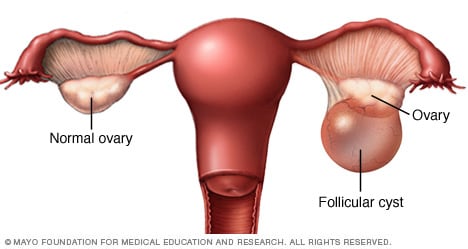
A cyst is a closed sac-like structure that is not a normal part of the tissue where it is found. Cysts are common and can occur anywhere in the body in people of any age. Cysts symptoms and signs vary with the type of cyst.
Read about cyst causes, such as infections, tumors, and defects. Around the midpoint of your menstrual cycle, an egg bursts out of its follicle and travels down the fallopian tube. When a follicle releases its egg, it begins producing estrogen and progesterone for conception.
An ovarian cyst is an enclosed sac-like structure filled with fluid or semi-solid material located in the ovary. Ovarian cysts are very common and can arise due to a number of causes. Causes of ovarian cysts include hormonal changes during the menstrual cycle (follicular cysts), endometriosis, benign tumors, and cysts due to polycystic ovary syndrome (PCOS). Most of the time they’re painless and harmless. Most ovarian cysts do not cause any signs or symptoms and they go away on their own.

This is particularly true of functional cysts. However, a large cyst can cause some discomfort. Also, you may start noticing symptoms if the cyst starts bleeding, breaks open, twists the fallopian tube or interferes with the blood supply to the ovary. Developing an ovarian cyst is usually not a cause for concern. There are two different types of ovarian cysts and both may cause symptoms such as abdominal bloating, painful bowel movements, and.
Most women produce at least one cyst each month, but they are painless and they disappear quickly. There are different types of ovarian cysts and the ones that normally cause pain or complications are the ones that women are talking about when they talk about ovarian cysts. What is trichilemmal cyst. A trichilemmal cyst is also known as a pilar cyst or “wens”, is a keratin-filled cyst that originates from the outer hair root sheath that are most often found on the scalp. Pilar cysts are smooth and mobile, filled with keratin (a protein component found in hair, nails, and skin), and they may or may not be tender.
Risk factors for developing a cyst are related to the underlying causes of the cyst formation. Most cysts are asymptomatic and have no signs. Breast cancer is cancer of the breast tissue, and is the second-most common type of cancer in women, and the second-leading cause of cancer deaths in women.
Breast lumps are common, and are signs of changes in breast tissue. Most breast lumps are not cancerous. Often there are no symptoms. If symptoms do occur these may include swelling and pain behind the knee. Many women experience an ovarian cyst during their lifetimes, but most are harmless.

Bartholin cyst signs and symptoms. If the cyst grows, you might feel a lump or mass near your vaginal opening. Sebaceous cysts are common noncancerous cysts of the skin. Cysts are abnormalities in the body that may contain liquid or semiliquid material.
Cysts that twist or rupture cause a serious medical condition. Women who experience the symptoms of. But the fact of the scientific matter is that it’s completely non-cancerous and does not harm your body that severely as you think. A thyroglossal cyst is a fibrous cyst that forms from a persistent thyroglossal duct.
Thyroglossal cysts can be defined as an irregular neck mass or a lump which develops from cells and tissues left over after the formation of the thyroid gland during developmental stages. Occasionally they may produce bloating, lower abdominal pain, or lower back pain. The majority of cysts are harmless.
This may result in vomiting or feeling faint. There are several signs of hydatid cysts seen associated with hydatid disease: cumbo sign: air is seen between the pericyst and the laminated membrane of the cyst serpent sign: internal rupture of the cyst with collapse of membranes of the par.
Hiç yorum yok:
Yorum Gönder
Not: Yalnızca bu blogun üyesi yorum gönderebilir.